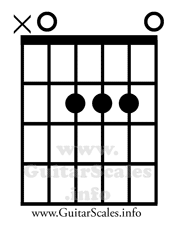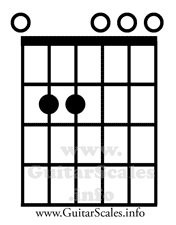Part 4 of our Beginning Guitar series looks at guitar notation and the differences between the different systems.
Guitar Music Notation
Many great guitarists do not read music of any type, relying on their ears and improvisation skills to produce their music. However, it’s a very useful ability to have, and most guitarists can follow chord charts, and read tablature (TAB – see below) at the very least. If you want to become a session guitarist, or are learning classical (Spanish) guitar, you will need to be able to read traditional music notation.
[ad name="Google Adsense Lge Rec"]
Guitar Chords and Chord Notation
Guitar chords are often represented by chord boxes, which show a top-down view of the guitar neck, with dots or numbers showing where the fingers should be placed. If numbers are used, the index finger is 1, going up to the little finger (pinkie) which is 4.
There is huge variety of guitar chords, and even chords of the same type (e.g. major, minor, seventh) can be played in different ways. The most common types of chord are major chords (represented by just their pitch name, i.e. ‘A’), minor chords, (represented by their pitch followed by 'm', i.e. ‘Am’) and dominant seventh chords (shown by the pitch followed by a ''7', i.e. A7 - often just called 'seven' or seventh' chords). Generally, major chords give a happy, bright sound, minor chords give a sad, subdued sound, and seventh chords give an expectant sound.
Chords are often shown just by their symbols (i.e. A, am, A7), and a chord chart is simply a sequence of chord symbols for a guitarist to follow. The guitarist should choose for themselves how each chord is played (if they knows more than one way of playing it!). Below are examples of guitar chord boxes, and a sample chord chart.
A major chord

See more here: A Chord Guitar
E minor chord

See More Here: Em Guitar Chord
Sample Chord Chart:

[ad name="Google Adsense Lge Rec"]
In the chord chart above, the guitarist would play one and a half bars of a D minor 7 chord, half a bar of G dominant seventh chord, followed by a further two bars of D minor 7. The guitarist would usually just strum the chords, using a suitable strumming pattern for the song.
Guitar Tablature (Guitar TAB)
Tablature is actually a very old form of notation, having been used for early fretted instruments. It is a visual representation of the guitar neck, showing at which fret the fingers should be positioned. It is very easily understood, especially if the reader already knows roughly how the music goes, but is not as flexible as traditional music notation, and does not represent the note rhythms (as opposed to pitches) very well. Tablature is often shown in conjunction with traditional music notation. Here is ‘Twinkle, Twinkle Little Star’ in traditional music notation (top line) and TAB (bottom line) – see if you can work out how it works:

Traditional Music Notation
Traditional music notation shows the pitches and durations of notes. Generally, the vertical position of the note heads on the stave shows how high or low their pitch is, and their duration is shown by the note head’s shape and by the presence and shape of the tail by the side of the note head. The way in which notes are grouped also gives the reader an instant idea of the rhythm the notes should be played in. It may seem complicated at first, but is a fairly simple system once the basics have been mastered.
Related Articles:
Beginning Guitar Part 2 : Guitar Strings & Guitar Tuning
Beginning Guitar Part 3 : Guitar Playing Techniques
Beginning Guitar Part 4 : Guitar Music Notation
Beginning Guitar Part 5 : Guitar Amplifiers & Guitar Effects



Good info. Every guitarist should learn to read music.
good information, very helpful for the beginner.